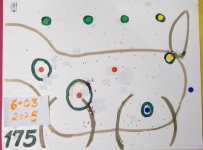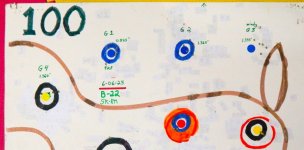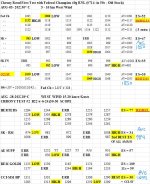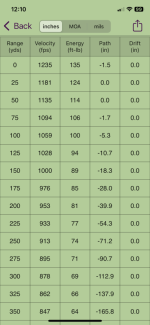Big enough to catch that drop. I wouldn't waste my time firing any first shot at 100 yards without having a large enough target to catch the drop or error. I usually staple an extra target or blank page beneath the target when I take my first shot at 100.How big is your paper?
You are using an out of date browser. It may not display this or other websites correctly.
You should upgrade or use an alternative browser.
You should upgrade or use an alternative browser.
100 yard zero
- Thread starter SPACEFORCE
- Start date
I wouldn't waste time zeroing a .22LR at 100 yards, since it will never be a true zero outside of a basement tunnel. We are not the same.Big enough to catch that drop. I wouldn't waste my time firing any first shot at 100 yards without having a large enough target to catch the drop or error. I usually staple an extra target or blank page beneath the target when I take my first shot at 100.
Wind or air movement often makes a zero difficult to maintain at 100 yards when shooting outdoors. Slight changes, which can move a round quite a bit, can often be difficult to detect. Sometimes ammo plays a role that is difficult to understand. At least one round in the ten-shot group from last weekend shown below was off the zero.
But more seriously, there's no need to worry about bore sighting if a shooter first zeros at closer distances and moves to longer ones incrementally. I sight in at 25 yards first, then at 50, and finally at 100. When zeroed at 50 a .22LR bullet will drop about eight inches by the time it gets to 100.
I have never used a boresight. I once watched a friend who paid a gun shop to bore sight a scope try and fail to hit paper at 100. He grew frustrated and felt he spent his money poorly.

But more seriously, there's no need to worry about bore sighting if a shooter first zeros at closer distances and moves to longer ones incrementally. I sight in at 25 yards first, then at 50, and finally at 100. When zeroed at 50 a .22LR bullet will drop about eight inches by the time it gets to 100.
I have never used a boresight. I once watched a friend who paid a gun shop to bore sight a scope try and fail to hit paper at 100. He grew frustrated and felt he spent his money poorly.

- Location
- Nova Scotia
I mean its recommended to zero at 25 after bore sighting.Wind or air movement often makes a zero difficult to maintain at 100 yards when shooting outdoors. Slight changes, which can move a round quite a bit, can often be difficult to detect. Sometimes ammo plays a role that is difficult to understand. At least one round in the ten-shot group from last weekend shown below was off the zero.
But more seriously, there's no need to worry about bore sighting if a shooter first zeros at closer distances and moves to longer ones incrementally. I sight in at 25 yards first, then at 50, and finally at 100. When zeroed at 50 a .22LR bullet will drop about eight inches by the time it gets to 100.
I have never used a boresight. I once watched a friend who paid a gun shop to bore sight a scope try and fail to hit paper at 100. He grew frustrated and felt he spent his money poorly.
I made a grid on my basement wall for bore sighting. Mainly just took guns that I knew was zeroed at set ranges. Kept the same POA and marked where the reticle rested.
But I still like shooting at fresh cardboard.
I usually use an 'in-bore' laser at 20-yds to zero a new rifle or scope, in my back-yard. At Dusk I can see the laser on a target better, and less likely for 'any bystanders' to be around  I have a relatively 'private' yard, esp with trees in full leaf now. I then go to the range and use Dollar store poster board (2/$1.25) and 1/4" sticky dots for targets if I'm zeroing a scope. Also 3/4" dots are available. Or mount a 'home-printed' target. The poster horizontally is usually OK for 'first shots' but I can mount it vertically if needed. I also draw silhouettes of 'tall animals' or others on the posters, for variety.
I have a relatively 'private' yard, esp with trees in full leaf now. I then go to the range and use Dollar store poster board (2/$1.25) and 1/4" sticky dots for targets if I'm zeroing a scope. Also 3/4" dots are available. Or mount a 'home-printed' target. The poster horizontally is usually OK for 'first shots' but I can mount it vertically if needed. I also draw silhouettes of 'tall animals' or others on the posters, for variety.
First shots with new2me Savage 12 and Sav B22 FV at 100 with new Athlon 8-34x56 FFP scope just mounted w/o laser Zee before shooting->


First shots with new2me Savage 12 and Sav B22 FV at 100 with new Athlon 8-34x56 FFP scope just mounted w/o laser Zee before shooting->


Last edited:
My system for "Gopher Accuracy" is to sight in at 50 yards.
My scope for this purpose has four stadia but three will work.
Now with a target at 100 yards, each stadia is plotted and the third stadia was shooting about 1/2" high at 100 yards.
In between the crosshairs and the third stadia is simply a matter of plotting a trajectory based on distance.
It is much like metallic Silhouette shooting where your shots are dialed in for 40, 60, 77 and 100 metres.
My scope for this purpose has four stadia but three will work.
Now with a target at 100 yards, each stadia is plotted and the third stadia was shooting about 1/2" high at 100 yards.
In between the crosshairs and the third stadia is simply a matter of plotting a trajectory based on distance.
It is much like metallic Silhouette shooting where your shots are dialed in for 40, 60, 77 and 100 metres.
When sighted in for 25 yards your zero at 50 will be so close a gopher can't tell the difference..I mean its recommended to zero at 25 after bore sighting.
I made a grid on my basement wall for bore sighting. Mainly just took guns that I knew was zeroed at set ranges. Kept the same POA and marked where the reticle rested.
But I still like shooting at fresh cardboard.
If you’re sighted in at 25 yards, you don’t have a zero at 50. It’s at 25.When sighted in for 25 yards your zero at 50 will be so close a gopher can't tell the difference..
- Location
- Nova Scotia
Depends on the gun. Its one of those things you basically just gotta make your own chart.When sighted in for 25 yards your zero at 50 will be so close a gopher can't tell the difference..
That's a good reminder that ballistic charts show the trajectory - depending on certain conditions. Barrel length for one, and other things may very well add up to noticable differences from a chart.Depends on the gun. Its one of those things you basically just gotta make your own chart.
Theory vs experience.
How big a targetI take the bolt out and boresight on traget at 100. Usually on paper with the first shot.
Im not quite sure how so many think boresighting a rifle is such vudoo. Been doing it for 45 plus years and its not really that complicated.
It depends on how close your talking. My rifles are sighted at 50 yards and at25 yards to thread the needle I require 4 clicks down in moa to hit exactly at POA. It translates to 1/4" at 25 yards and its close enough but not exact and as mentioned will be different for most rifles depending on height of optic above bore,ammo speed etc. The scopes I use allow 4 clicks below once the zero stops been set.If you’re sighted in at 25 yards, you don’t have a zero at 50. It’s at 25.
If you have to make, “clicks” you’re not sighted in at 25 and 50.
There’s nothing voodoo about boresighting. I’m just calling bull#### on boresighting at 100 yards with a 22 and being on paper first shot, unless the berm is “paper”.
There’s nothing voodoo about boresighting. I’m just calling bull#### on boresighting at 100 yards with a 22 and being on paper first shot, unless the berm is “paper”.
Last edited:
Just as a point of reference - the last time I bore sighted a rifle was at 50 yards at an 18" x 24" target. I was just on the paper with the first shot.
And I was just using a front bag and doing my best. I can imagine doing it at 100 yards if you got the rifle in a sled and used a good laser bore sighter.
And I was just using a front bag and doing my best. I can imagine doing it at 100 yards if you got the rifle in a sled and used a good laser bore sighter.
Last edited:
Thankfully we live in a time where technology is so advance, it would be extremely easy to make a video putting a laser bore sighter on paper at 100 yards, aligning the optic to the laser, and being on (a reasonably sized) piece of paper with the first shot. We all know full well that isn’t going to happen.
If you're sighted in at 25 yards, you very nearly have a zero at 50. A ballistics calculator shows that a CCI SV round that's zeroed at 25 will be just over 1/2" low at 50 yards; a CCI Mini-mag 40 grain round will be about .15" low at 50. This is with a scope that is 1.5" above the center of the bore. That may be close enough for gophers.If you’re sighted in at 25 yards, you don’t have a zero at 50. It’s at 25.
Ballistics charts show how a trajectory should be when the bullet behaves according to known inputs such as MV, scope height above bore, and even wind and temperature. The barrel length is irrelevant. Why? Once a bullet leaves the muzzle it's flight is unaffected by the length of the bore it passed through on its way to flight.That's a good reminder that ballistic charts show the trajectory - depending on certain conditions. Barrel length for one, and other things may very well add up to noticable differences from a chart.
With .22LR ballistics charts can't account for things that can't be given as an input. For example, any imperfection or irregularity in the bullet shape (particularly the heel, which is always unseen by the shooter), center of gravity, or weight usually remain unknown to the user but they can affect trajectory. Imperfections such as these are among the reasons for .22LR bullets not always behaving as ballistics calculators predict.
As for bore sighting at 100, next time anyone is shooting at 100 yards, take the bolt out of the rifle and look down the bore. A 8.5 X 11 paper wouldn't be all that easy to make the center of what is seen through the bore. Perhaps it can be done but it wouldn't necessarily be a simple thing. That's why a lot of .22LR shooters sight in at closer distances before moving to 100.
Doesn't the length of a barrel affect the bullet velocity?Ballistics charts show how a trajectory should be when the bullet behaves according to known inputs such as MV, scope height above bore, and even wind and temperature. The barrel length is irrelevant. Why? Once a bullet leaves the muzzle it's flight is unaffected by the length of the bore it passed through on its way to flight.
Last edited:
as far as barrel length, variations make minor velocity changes, per this F-A Wiki chart - https://www.firearmwiki.com/wiki/.22_LR_Velocity_By_Barrel_Length .
As well, the 1235 figure quoted in the chart in post 92, that's CCI's 'average advertised speed', not to be relied on per many anecdotal comments. Here is a 'personal one' from 2022, fired thru my Savage B-22-FV 21" barrel (only) - the last entry in the chart attached. NONE of the speeds I list are 1235 . All are much higher

As well, the 1235 figure quoted in the chart in post 92, that's CCI's 'average advertised speed', not to be relied on per many anecdotal comments. Here is a 'personal one' from 2022, fired thru my Savage B-22-FV 21" barrel (only) - the last entry in the chart attached. NONE of the speeds I list are 1235 . All are much higher

Thanks for the reference. I was wrong - only really short barrels seem to have any meaningful affect on muzzle velocity.as far as barrel length, variations make minor velocity changes, per this F-A Wiki chart - https://www.firearmwiki.com/wiki/.22_LR_Velocity_By_Barrel_Length .
As well, the 1235 figure quoted in the chart in post 92, that's CCI's 'average advertised speed', not to be relied on per many anecdotal comments. Here is a 'personal one' from 2022, fired thru my Savage B-22-FV 21" barrel (only) - the last entry in the chart attached. NONE of the speeds I list are 1235 . All are much higher
It's also interesting that the CCI SV and Mini-Mags had the most consistent velocity.
Cheers,
Marlin989







































































